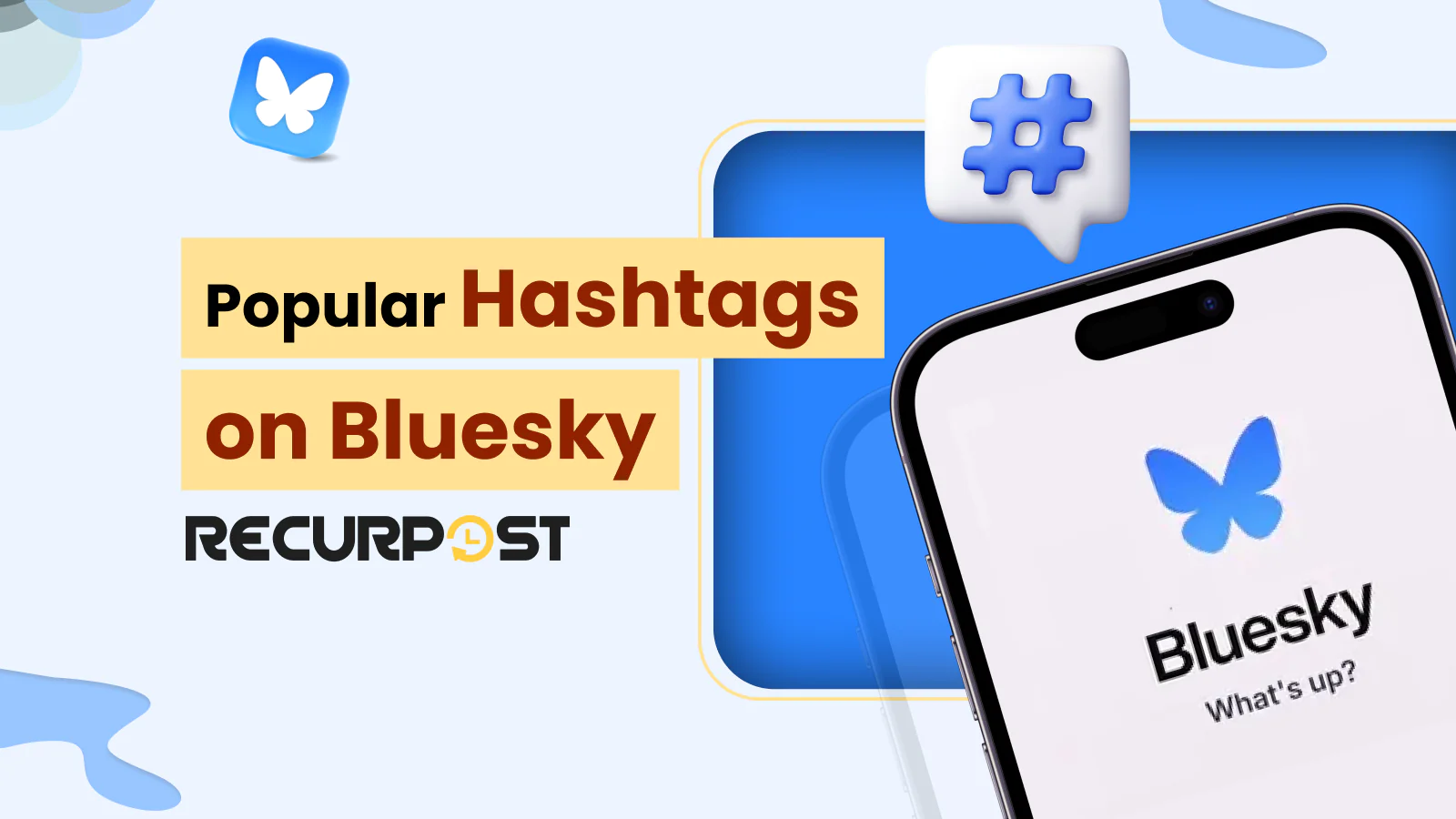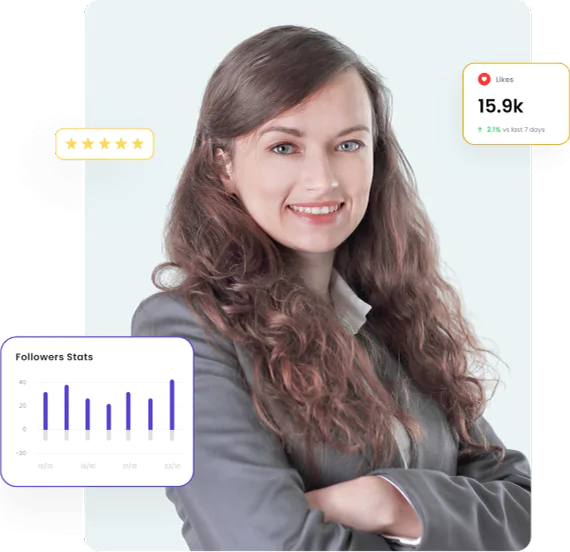Trying to stand out on Bluesky? Start with the right hashtags.
Bluesky might be the new kid on the block, but it’s growing fast. With over 35.98 million users already and a 30% annual growth rate, your posts are competing with a lot of noise. Hashtags are your shortcut to visibility.
Bluesky doesn’t have a trending tab or universal hashtag search, making it challenging to identify popular hashtags.
That’s what this guide is for.
We’ve scanned the platform, talked to active users, and tracked what’s showing up in feeds. You’ll find the most popular hashtags on Bluesky right now, along with tips on how to use them to get seen.
Let’s get you discovered.
Why Hashtags Matter on Bluesky
If you’ve used social media before, you’re probably familiar with hashtags. But hashtags on Bluesky serve an even more critical function than on other platforms.
Bluesky hashtags enable content discovery in both algorithmic and chronological feeds. When you add a hashtag to your post, you’re essentially categorizing it and making it discoverable to others interested in that topic.
This feature is especially important on Bluesky because the platform doesn’t have a native “Trending page” like Twitter or Instagram.
Without a centralized trending page, tags drive organic discovery on Bluesky. When users search for a specific hashtag, they can find all posts tagged with it, regardless of who posted them or whether they follow those accounts. This makes hashtags one of the primary ways new connections form on the platform.
Bluesky uses hashtags like other social networks, but with unique technical differences explained later in this guide.
Bluesky’s Architecture & Hashtag Implementation
1. AT Protocol Overview
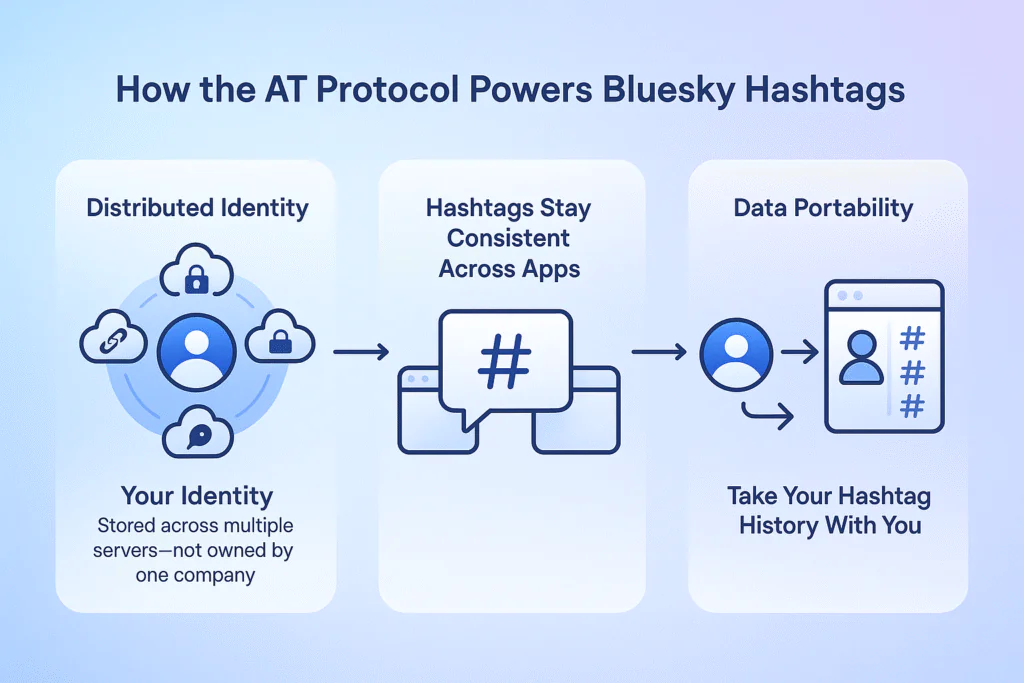
The AT Protocol (Authenticated Transfer Protocol) powers Bluesky’s innovative social networking platform. This protocol determines how hashtags function within the Bluesky ecosystem.
The AT Protocol enables distributed identity and data management, allowing users to maintain their digital presence across various servers and applications, unlike conventional platforms where a single company controls identity and content.
Hashtags embedded within post metadata remain accessible to any AT Protocol-compatible client, ensuring consistent behavior throughout the network regardless of which Bluesky client you use.
Additionally, the protocol’s architecture makes hashtag data transferable. When you migrate to another Bluesky client or as new applications emerge, your hashtag history and the relationships you’ve built through hashtags stay preserved.
2. Feed Types & Hashtags
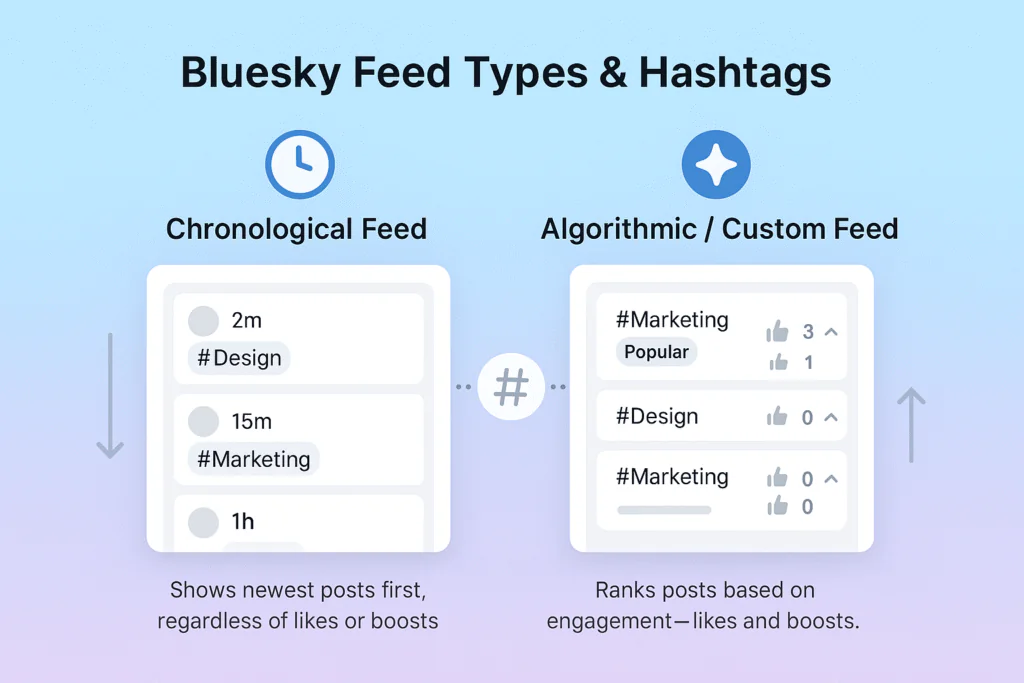
Bluesky offers different types of feeds, and hashtags play a unique role in each one. Knowing how these differences work improves your hashtag strategy.
- The chronological feed shows all posts under a tag by timestamp. When you search for a hashtag in this feed, you’ll see the most recent posts first, regardless of their popularity or engagement levels. This is similar to how hashtag searches worked on early Twitter, before algorithmic sorting became prevalent.
- In contrast, algorithmic/custom feeds weight engagement metrics like likes and boosts when surfacing tagged content. These feeds might prioritize posts that have received more engagement, even if they’re not the most recent. This helps surface quality content that might otherwise get buried in a purely chronological feed.
Custom feeds can also be created by users and developers to filter content based on specific criteria, including hashtags. For example, you might create or subscribe to a custom feed that shows posts with multiple art-related hashtags from accounts with a minimum follower count.
3. Spring 2024 Hashtag Launch
While Bluesky launched in 2023, full hashtag functionality wasn’t implemented until Spring 2024. This update brought several improvements to how hashtags work on the platform.
The Spring 2024 update introduced full support for multi-word tags, underscores, and numeric characters. This means you can use hashtags like #PhotoOfTheDay, #Summer_2025, or #Top10Tips without any issues.
The update also established a character limit of 100 characters per hashtag, which is quite generous compared to other platforms. Special characters are stripped except for underscores, which helps maintain consistency and searchability across the platform.
These technical details might seem minor, but they have a significant impact on how hashtags function and how users interact with them. The flexibility of Bluesky’s hashtag system allows for more nuanced categorization and discovery than many other social platforms.
Bluesky Hashtag Generator: Free AI Tool for Viral Posts
Our free Bluesky hashtag generator creates relevant hashtags for your posts. Use this AI tool to find the perfect Bluesky hashtags and increase your reach.
Real-Time Trending Hashtags (September 2025)
As of September 2025, Bluesky’s hashtag ecosystem is thriving with diverse communities and interests. The platform doesn’t have an official trending page, but third-party tools like trendingworld.bsky.social takes snapshots of the “firehose” (the stream of all public posts) every 30 minutes to identify trending tags.
Tags from the last 30 minutes 🧭:1. #art 2. #bb27 3. #Auspol 4. #writingcommunity 5. #OC 6. #Trump 7. #AI 8. #digitalart 9. #wip 10. #EmmysAd: @terraprotege.bsky.social.
— Trending – World (@trendingworld.bsky.social) September 15, 2025 at 5:30 PM
From the above list, these are the top 10 popular hashtags on Bluesky:
- #art
- #bb27
- #Auspol
- #writingcommunity
- #OC
- #Trump
- #AI
- #digitalart
- #wip
- #Emmys
Here are some of the most popular hashtags across different categories:
| Category | Hashtag | Posts/hr | Impressions/30 min |
| Art | #art | 1,800 | 25,000 |
| Lifestyle | #caturday | 1,200 | 18,500 |
| Fandom | #Superman | 950 | 12,000 |
| Creative | #oc | 800 | 10,500 |
| Local | #Texas | 600 | 8,700 |
| Morning | #GoodMorning | 550 | 7,200 |
- #art: The #art hashtag consistently ranks as one of the most used tags on Bluesky, reflecting the platform’s strong creative community. With 1,800 posts per hour and 25,000 impressions every 30 minutes, it’s clear that art content performs exceptionally well on Bluesky.
- #caturday: Lifestyle tags like #caturday show the platform’s more casual, fun side. This tag peaks on Saturdays (as you might expect) but maintains steady usage throughout the week.
- #Superman: Fandom hashtags like #Superman tend to spike around events like movie releases or comic conventions. These tags create temporary but highly engaged communities.
- #oc: The creative community on Bluesky extends beyond traditional art, with tags like #oc (original content) gaining significant traction. This tag spans various media types, from writing to digital art to music.
- #Texas: Local hashtags like #Texas show how Bluesky users are forming geographic communities. These tags help users connect with others in their area and discover local events or news.
- #GoodMorning: Time-based tags like #GoodMorning create daily rituals and community interactions. These tags tend to follow global time zones, with usage moving across regions as different parts of the world start their day.
Tip: Check Bluesky’s firehose via public clients or RecurPost’s Trending Tags widget daily to stay on top of emerging trends. Hashtag popularity can shift quickly, especially around current events or seasonal themes.
Anatomy & Technical Details of Bluesky Hashtags
1. Syntax Rules
Bluesky follows simple rules for creating hashtags:
- Prefix: Every hashtag starts with #.
- Max length: 100 characters.
- Characters: You can use letters, numbers, and underscores (_).
- Multi-word tags: No spaces are allowed, so use underscores instead (e.g., #PhotoOfTheDay).
- Special characters: All special characters except underscores are automatically removed by Bluesky’s clients.
2. AT Protocol Representation
Hashtags on Bluesky are saved in a structured part of each post’s data, not just in the text. They’re stored in something called a “hashtags array,” which is a format that apps can easily read. So any app built on the AT Protocol can spot and display those hashtags without guessing. It’s all neatly organized behind the scenes.
This standardization is what allows hashtags to work consistently across different Bluesky clients and servers. It also enables developers to create tools that can analyze hashtag usage and trends across the entire Bluesky network.
The AT Protocol’s approach to hashtags reflects its broader philosophy of data portability and interoperability. Your hashtags aren’t just visible within a single application; they’re part of the protocol-level metadata that travels with your posts wherever they appear in the AT ecosystem.
3. Special Handling
Bluesky implements several special handling rules for hashtags that affect how they function on the platform. One of the most notable is case-insensitive matching.
#Art, #ART, and #art are all treated as the same hashtag. When you search for any of these variations, you’ll see posts with all case variations.
Bluesky hashtags are not case-sensitive. The system treats different capitalizations as identical for search and discovery purposes while preserving original capitalization in post-display.
Duplicate hashtags in a single post are automatically merged. If you include #art multiple times in one post, it will only be counted and indexed once. This prevents hashtag stuffing and keeps posts cleaner.
Unsupported symbols are automatically removed by client libraries. If you try to use a hashtag like #art&design, it would be processed as #artdesign. This automatic cleaning helps maintain consistency in how hashtags function across the platform.
Measuring Popularity: Quantitative Metrics
These quantitative metrics measure a hashtag’s reach, engagement, and longevity on Bluesky.
| Metric | Definition | Sample Value |
| Posts per hour | Volume of new tagged posts | 1,800 |
| Total impressions | Views across all posts with the tag | 25,000 |
| Engagement rate (%) | (likes + replies + boosts)/impressions ×100 | 12% |
| Unique users | Distinct accounts using the tag | 620 |
| Trending window (hrs) | Duration tag stays above threshold volume | 24–48 |
- Posts per hour counts new posts created with a particular hashtag each hour, with high-volume hashtags like #art reaching 1,800+ posts hourly during peak times.
- Total impressions measure views of posts with a particular hashtag, indicating reach beyond post count. A hashtag generating 25,000 impressions in 30 minutes reaches a significant audience.
- Engagement rate equals (likes + replies + boosts) / impressions x 100. Healthy Bluesky engagement rates range from 8-15%, with 12% representing a strong average for popular hashtags.
- Unique users count different accounts using a particular hashtag, distinguishing between broadly adopted hashtags versus those used repeatedly by smaller user groups.
- Trending window measures the duration a hashtag maintains above-threshold volume, typically 24-48 hours before returning to baseline, though evergreen hashtags maintain consistent usage patterns.
Tip: Use RecurPost’s CSV export feature to track these metrics over time for hashtags relevant to your content. This historical data can help you identify patterns and optimize your hashtag strategy.
How RecurPost Integrates with Bluesky
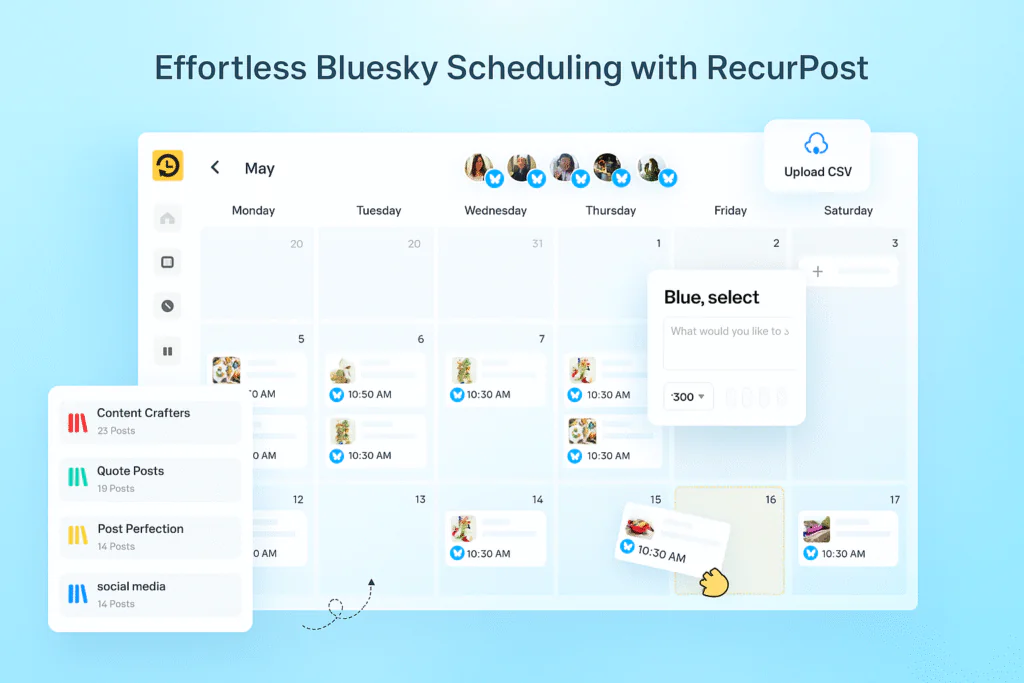
RecurPost, a social media scheduling tool, added native scheduling support for Bluesky. This allows users to schedule posts directly on Bluesky while also tracking hashtag performance through the RecurPost analytics dashboard. With RecurPost, you can:
- Schedule posts with relevant hashtags
- Track the performance of hashtags in real-time
- Monitor your content’s performance across different social media platforms (including Bluesky)
By utilizing RecurPost’s analytics, you can get valuable insights into which hashtags are generating the most engagement, helping you refine your hashtag strategy and maximize your reach.
Scheduling Hashtags with RecurPost
Step-by-Step Scheduling
RecurPost makes it easy to schedule Bluesky posts with optimized hashtags. Here’s how to get started:
- Go to RecurPost and log in with your account.
- Navigate to the “Accounts” section and add your Bluesky account under “Add social profiles” by following the prompts.
- Click on “Share a Post” and choose your Bluesky profile.
- Add your text, links, and images (if any) for the post, then tap Customize.
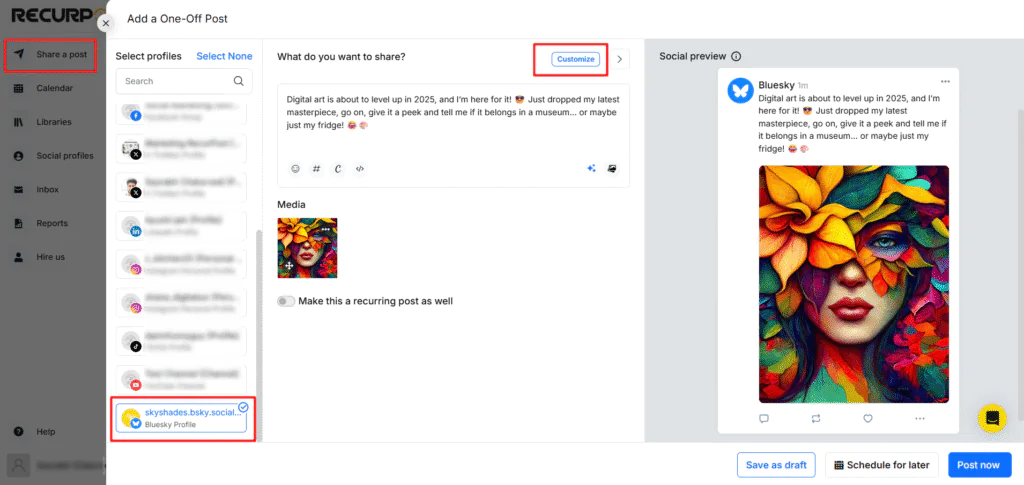
- Use niche-specific hashtags that match your post content. Keep them relevant, popular, and tailored to your audience. Tap the blue AI icon for Bluesky-specific suggestions, or try the free RecurPost hashtag generator.
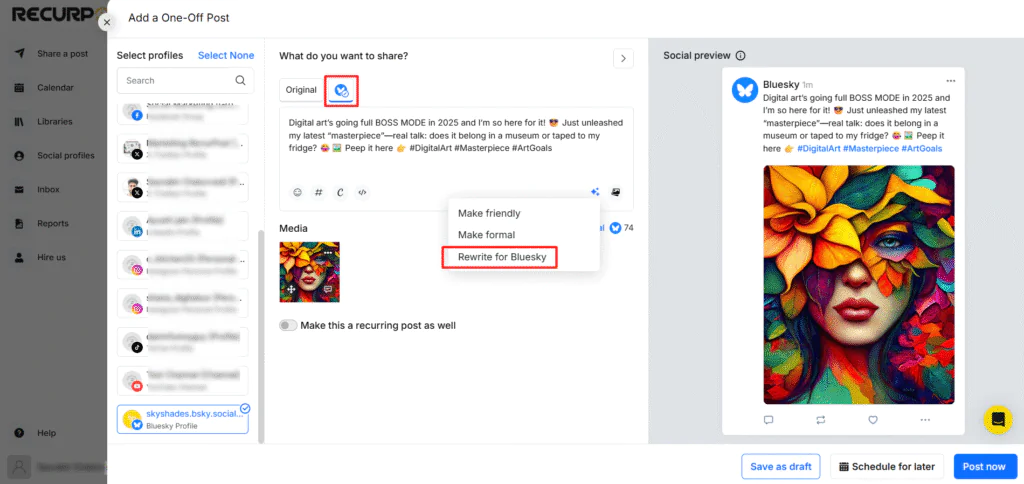
- Select “Schedule for Later” and choose a date and time when your audience is most active, or simply click “Auto-Schedule” to let the system pick the optimal time.
- If you want the post to repeat, add it to a RecurPost content library for future reuse. (This step is optional.)
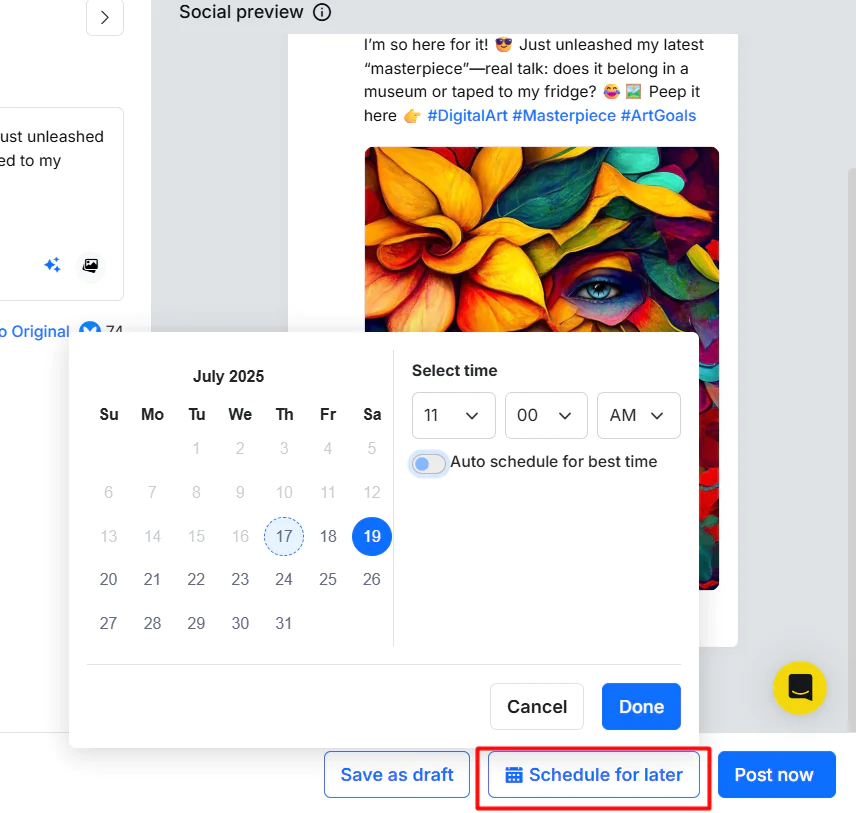
- Finalize by clicking the scheduling option.
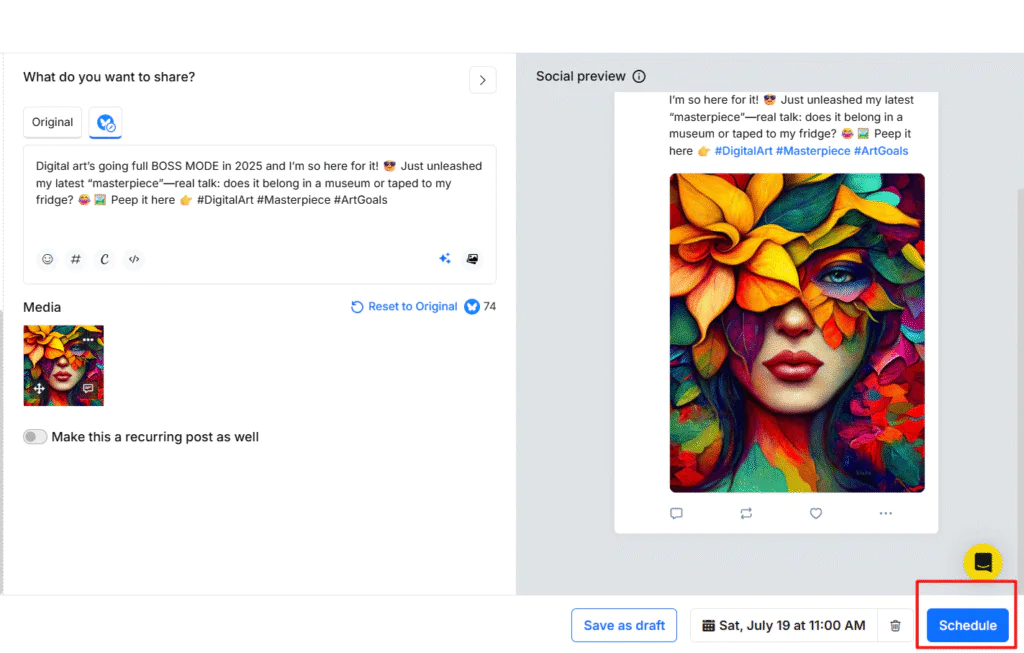
Content Library
One of RecurPost’s most time-saving features is its content library, which allows you to save frequently used tag groups for one-click insertion.
For example, if you regularly post art content, you might create a tag group that includes #ArtShare, #Photography, #DigitalArt, and #CreativeMinds. Instead of typing these hashtags each time, you can insert the entire group with a single click.
The content library also allows you to organize hashtags by theme, audience, or campaign. This organization makes it easier to maintain a consistent hashtag strategy across multiple posts and content types.
You can also set up rotation rules for your hashtag groups. This feature automatically varies the hashtags used in your posts to prevent repetition and reach different audience segments.
Best Practices & Advanced Tips for Relevant Hashtags
Mastering hashtags on Bluesky requires more than just knowing which ones are popular. Here are some best practices and advanced tips to help you get the most out of your hashtag strategy:
- Mix Broad and Niche: Combine high-volume hashtags with more targeted ones. For example, pair a broad tag like #News with a niche tag like #LocalEvents. The broad tag gives you reach, while the niche tag helps you connect with a more specific audience.
- Limit Tags: While Bluesky doesn’t have a strict limit on the number of hashtags per post, using too many can make your content look spammy. Aim for 3-5 relevant hashtags per post to maintain readability while still maximizing discovery.
- Timing Matters: Schedule your posts around peak times in your audience’s time zone. For global audiences, this might mean scheduling multiple posts throughout the day to catch different time zones. RecurPost’s analytics can help you identify when your audience is most active.
- Refresh Tags Weekly: Hashtag popularity isn’t static. Monitor shifts in hashtag rankings and adjust your strategy accordingly. What works this week might not work next week, especially for Bluesky trending topics or current events.
- Leverage Communities: Join Bluesky groups that spotlight tag-specific content. Many communities have formed around specific hashtags, and participating in these communities can increase your visibility and engagement.
- Research Before Posting: Before using a hashtag, search for it on Bluesky to see what type of content is typically associated with it. This helps you avoid using hashtags in inappropriate contexts and ensures your content reaches the right audience.
- Create Branded Hashtags: If you’re building a brand or community on Bluesky, consider creating your own unique hashtag. Encourage your followers to use it when sharing related content to build a searchable collection of posts.
- Track Performance: Regularly review which hashtags are driving the most engagement for your content. Double down on what works and phase out what doesn’t.
Common Pitfalls & Solutions for Hashtag Usage
Even experienced Bluesky users can fall into common hashtag traps. Here are some pitfalls to avoid and solutions to implement:
| Pitfall | Impact | Fix |
| Overusing obscure tags | Low reach | Use tags with 500+ posts per hour |
| Tag-stuffing | Reduced readability | Use 3-5 high-value tags |
| Ignoring performance data | Missed opportunities | Review RecurPost analytics weekly |
| Scheduling at off-hours | Align posts with the audience’s active hours | Align posts with the audience’s active hours |
- Overusing obscure tags limits reach. Niche hashtags reach specific audiences, but tags with fewer than 500 posts per hour lack sufficient viewers. Balance niche tags with popular ones (those with 500+ posts per hour).
- Tag-stuffing (cramming too many hashtags into posts) creates a spammy appearance and reduces engagement. Focus on 3-5 high-value tags directly relevant to your content.
- Ignoring performance data misses strategy refinement opportunities. Many users select hashtags by intuition rather than performance metrics. Review RecurPost analytics weekly and adjust hashtag strategy based on data.
- Scheduling at off-hours reduces post visibility. Content posted when your audience is offline gets buried quickly. Align the posting schedule with your audience’s active hours on Bluesky.
- Using irrelevant hashtags to gain visibility can backfire. While it might temporarily increase your reach, it can damage your reputation and lead to lower engagement over time. Always ensure your hashtags are relevant to your content.
- Inconsistent hashtag usage makes it harder for followers to find all your content on a particular topic. Develop a consistent hashtag strategy for recurring content themes.
- Neglecting local or community-specific hashtags can mean missing out on connecting with nearby users or specific communities. Research and incorporate a relevant local or community hashtag.
Action Plan for Beginners
1. Install RecurPost: Sign up for RecurPost and link your Bluesky account.
2. Identify trending hashtags: Start by selecting popular hashtags from this post, or use RecurPost to check trending tags.
3. Schedule your first post: Prepare your content using the Bluesky post generator from RecurPost, include your hashtags, then choose the optimal time for posting.
4. Review performance: After 24 hours, analyze the engagement of your post using RecurPost’s analytics.
5. Iterate: Adjust your hashtags weekly based on performance to optimize reach.
Conclusion
Effective hashtags on Bluesky expand your reach and connect you with like-minded communities. Follow best practices, track performance, and use tools like RecurPost to maximize your content’s visibility and engagement on Bluesky.
Keep experimenting, stay on top of trends, and refine your hashtag strategy for continued success.
FAQs on Popular Hashtags on Bluesky
1. Can hashtags help categorize content beyond text posts, like videos or messages?
Absolutely. You can use hashtags in Bluesky posts that include videos or even threaded messages, making it easier for others to discover and categorize content that’s not just text-based. This helps keep everything searchable across the entire platform.
2. Do I need to use trending hashtags for better reach, or can niche tags work too?
You don’t always need trending hashtags. In fact, niche tags often lead to deeper community engagement and attract the right people who care about your content, especially if you’re tracking your progress over time.
3. Is there a way to track which hashtags bring more visibility to my posts?
While Bluesky doesn’t offer in-depth analytics yet, some third-party tools and scheduling apps like RecurPost can help you log which hashtags lead to more visibility and engagement. Keep a personal note or spreadsheet to monitor what’s working.
4. Should I add the same hashtags to every post I make?
Not really. Repeating the same hashtags without context might reduce impact over time. Putting a little more effort into choosing relevant tags for each post will help your content stay fresh and reach the right audience.
5. Can hashtags help in growing a personal brand or creator profile on Bluesky?
Definitely. Using consistent and relevant hashtags helps people recognize what you’re about, builds trust, and invites like-minded users to follow your journey. It’s a simple way to boost recognition without shouting into the void.
6. Do hashtags work differently in replies or comments compared to main posts?
Hashtags in replies or comments don’t show up as prominently across the network. For better reach and discoverability, keep your main hashtags in the original post, not buried in messages or replies.
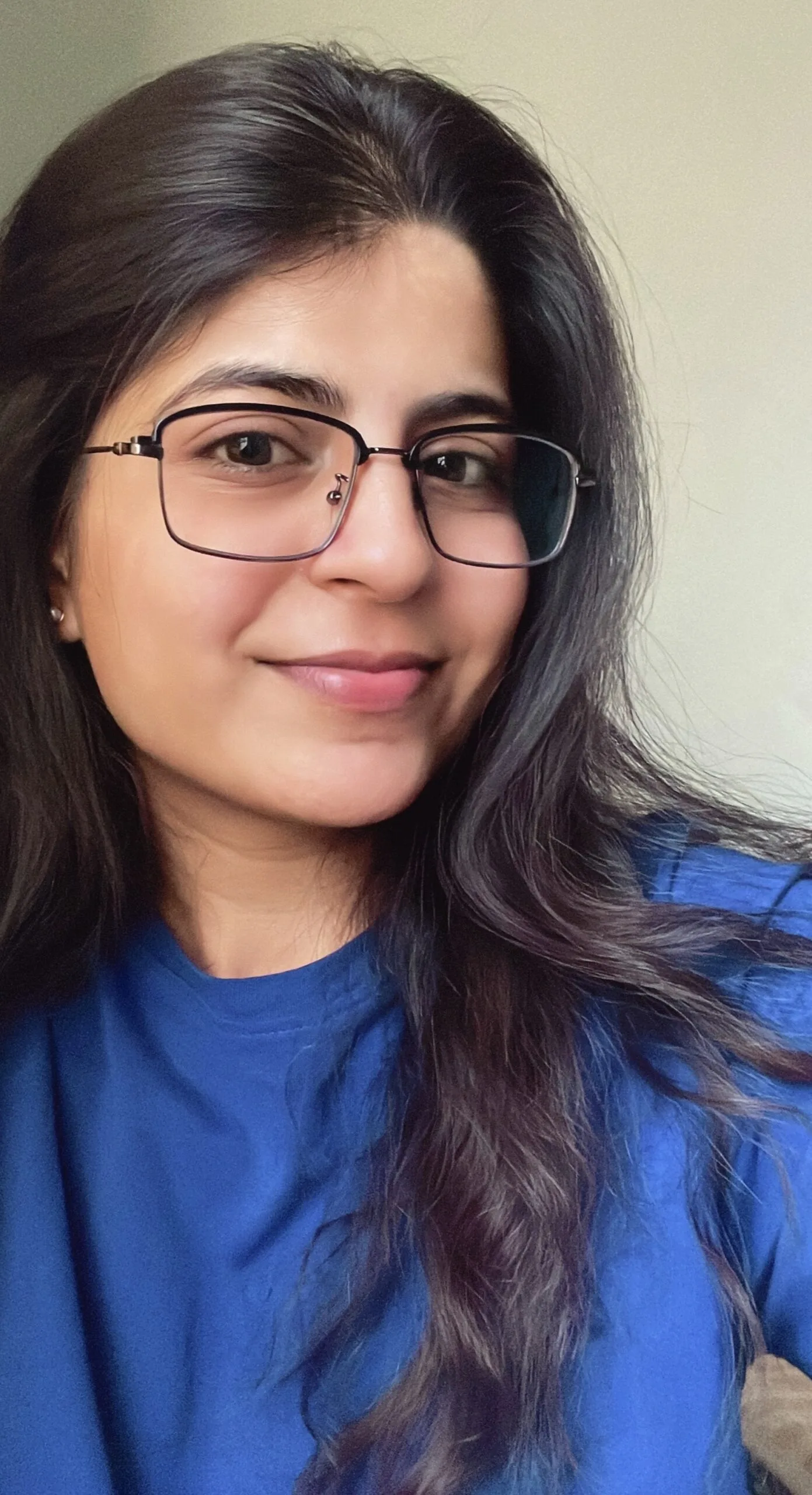
Shalini Nagar is an experienced content writer with a proven track record of creating diverse and engaging content across various formats. With years of expertise in crafting blogs, articles, she excels at delivering compelling narratives tailored to different audiences.
